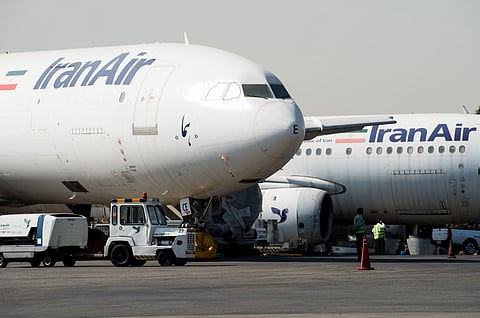Iran Air looks for planes and partners in post-sanctions order
Tehran-based airline is eager to expand its operations to meet rising travel demand

Iran’s national airline is preparing for the day when it’s finally released from the US sanctions that have worn down its fleet and crimped access to other nations.
With nuclear talks under way between Iran and the US, executives from Iran Air used the annual gathering of the International Air Transport Association in New Delhi last week to sound out potential airline partners and suppliers who were in attendance, according to people familiar with the matter.
Iran Air executives made contact with representatives from Japan Airlines Co., Vietnam Airlines and Royal Air Maroc as it seeks to line up codeshare agreements, the people said, asking not to be named discussing private matters. The encounters were mostly ad-hoc, they said, given the conference-hall setup and the sensitivities of doing business with Iran.
Executives from the state-owned carrier also dropped into an evening reception sponsored by Boeing Co. as they consider which aircraft Iran Air might acquire should US-made jets become accessible again, the people added.
Tehran-based Iran Air is eager to expand its operations to meet rising travel demand and is actively seeking new aircraft, spare parts and partnerships with carriers that fly to destinations it’s currently barred from serving, the people said.
The carrier aims to increase its fleet from fewer than 50 mostly grounded aircraft to at least 100 through direct purchases, if permitted, or by acquiring second-hand jets from foreign markets, the people said.
US President Donald Trump’s freewheeling approach to trade and foreign policy suggests the current diplomatic push could potentially lead to an opening for Iran Air after decades of restrictions. Boeing purchases took center stage in Trump’s recent Middle East trip, and were featured in a trade deal with the UK.
As yet, there’s no sign of a breakthrough. Supreme Leader Ayatollah Ali Khamenei last week pushed back against US pressure to cease Iran’s uranium enrichment programs, calling US demands “arrogant” and vowing not to give in.
Last week’s concentration of hundreds of aviation executives at the IATA event presented a prime opportunity for Iran Air to establish contacts, even where agreements aren’t currently possible. Several executives from carriers in countries that have normalized ties with Tehran say they are unlikely to sign pacts that could impair relationships with other airline partners.
For years, the sale of US-origin aircraft or related goods, technology or services to Iran has been barred without prior authorization, with violations subject to civil and criminal enforcement action by the Treasury’s Office of Foreign Assets Control. The European Union has also imposed restrictions.
Under the US-led sanctions, Boeing and Airbus SE can’t discuss plane or parts sales with Iran without a license. While there was brief contact between Boeing and Iran Air officials at the IATA reception, there were no commercial discussions, people familiar with the interaction said.
A Boeing representative declined to comment. Iran Air, Vietnam Airlines and Royal Air Maroc didn’t immediately respond to requests for comment.
A Japan Airlines spokesman said an Iran Air representative came by, but there was no substantial exchange of information.
Iran has faced suspicion for years over its nuclear ambitions and whether it’s developing the capability to fire an atomic weapon.
Since returning to the White House, Trump has said he wants a new agreement with Tehran, and the two sides kicked off fresh nuclear talks in mid-April. He is pouring on “maximum pressure” to speed the slow-moving talks, even drawing in Russian President Vladimir Putin for assistance.
Years of sanctions
Iran Air has a lot to gain from a breakthrough. Since its founding more than a half-century ago, the carrier has struggled to establish itself in a competitive international market.
US sanctions dating back to the 1979 Islamic Revolution have forced the airline to operate aging aircraft, sometimes cannibalizing grounded planes for spare parts, while remaining largely isolated from global markets.
The average in-service aircraft at Iran Air is over 20 years old, according to data from aviation consultancy Cirium.
In 2024, the EU also barred Iran Air from flying into the bloc because of Iran’s support for Russia. Among the airlines that still fly into Tehran are Emirates, Qatar Airways, Turkish Airlines and Deutsche Lufthansa AG.
Unlike most carriers, Iran Air handles nearly all of its own maintenance and relies on a network of brokers to source second-hand parts from carriers around the globe, the people said.
Iran Air is interested in acquiring jets from Boeing and Airbus, and has little appetite for Russian or Chinese alternatives, according to the people. In one recent deal, it obtained two used Airbus A330-200s from China, they said. With expansion in Europe curtailed, the company is looking to add services in Asia, including China, Thailand, Japan, India and Malaysia, the people said.
Iran Air’s longstanding maintenance workarounds, use of brokered parts and domestic repair shops present obstacles to a full reintegration with global networks. These practices have kept the fleet flying through the sanctions, though adding operational risks but their hodgepodge maintenance make Iran Air planes difficult to certify.
Iran managed to briefly re-engage with Western aerospace giants after a short-lived 2015 nuclear deal, placing orders with both Boeing and Airbus. It received a handful of planes before tensions between Tehran and Washington re-emerged, and the deal was called off.
Sign up for the Daily Briefing
Get the latest news and updates straight to your inbox



